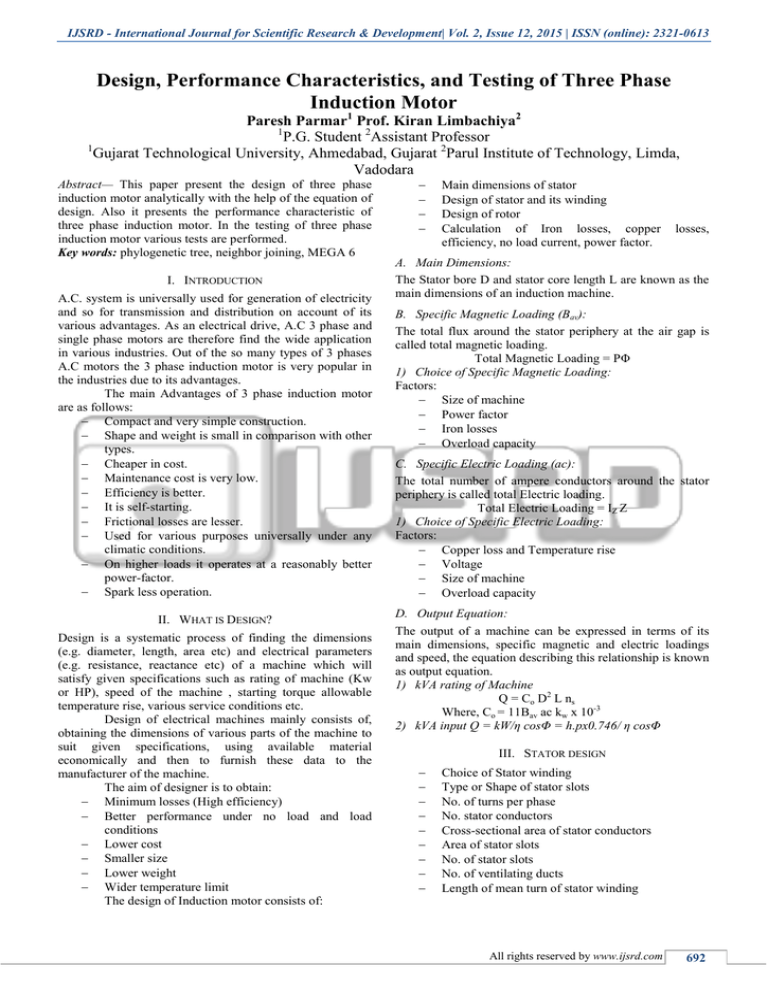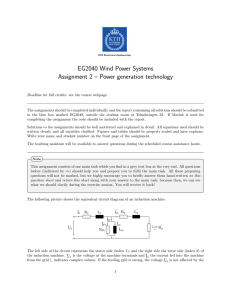
IJSRD - International Journal for Scientific Research & Development| Vol. 2, Issue 12, 2015 | ISSN (online): 2321-0613
Design, Performance Characteristics, and Testing of Three Phase
Induction Motor
Paresh Parmar1 Prof. Kiran Limbachiya2
1
P.G. Student 2Assistant Professor
1
Gujarat Technological University, Ahmedabad, Gujarat 2Parul Institute of Technology, Limda,
Vadodara
Abstract— This paper present the design of three phase
induction motor analytically with the help of the equation of
design. Also it presents the performance characteristic of
three phase induction motor. In the testing of three phase
induction motor various tests are performed.
Key words: phylogenetic tree, neighbor joining, MEGA 6
I. INTRODUCTION
A.C. system is universally used for generation of electricity
and so for transmission and distribution on account of its
various advantages. As an electrical drive, A.C 3 phase and
single phase motors are therefore find the wide application
in various industries. Out of the so many types of 3 phases
A.C motors the 3 phase induction motor is very popular in
the industries due to its advantages.
The main Advantages of 3 phase induction motor
are as follows:
Compact and very simple construction.
Shape and weight is small in comparison with other
types.
Cheaper in cost.
Maintenance cost is very low.
Efficiency is better.
It is self-starting.
Frictional losses are lesser.
Used for various purposes universally under any
climatic conditions.
On higher loads it operates at a reasonably better
power-factor.
Spark less operation.
II. WHAT IS DESIGN?
Design is a systematic process of finding the dimensions
(e.g. diameter, length, area etc) and electrical parameters
(e.g. resistance, reactance etc) of a machine which will
satisfy given specifications such as rating of machine (Kw
or HP), speed of the machine , starting torque allowable
temperature rise, various service conditions etc.
Design of electrical machines mainly consists of,
obtaining the dimensions of various parts of the machine to
suit given specifications, using available material
economically and then to furnish these data to the
manufacturer of the machine.
The aim of designer is to obtain:
Minimum losses (High efficiency)
Better performance under no load and load
conditions
Lower cost
Smaller size
Lower weight
Wider temperature limit
The design of Induction motor consists of:
Main dimensions of stator
Design of stator and its winding
Design of rotor
Calculation of Iron losses, copper
efficiency, no load current, power factor.
losses,
A. Main Dimensions:
The Stator bore D and stator core length L are known as the
main dimensions of an induction machine.
B. Specific Magnetic Loading (Bav):
The total flux around the stator periphery at the air gap is
called total magnetic loading.
Total Magnetic Loading = PΦ
1) Choice of Specific Magnetic Loading:
Factors:
Size of machine
Power factor
Iron losses
Overload capacity
C. Specific Electric Loading (ac):
The total number of ampere conductors around the stator
periphery is called total Electric loading.
Total Electric Loading = IZ Z
1) Choice of Specific Electric Loading:
Factors:
Copper loss and Temperature rise
Voltage
Size of machine
Overload capacity
D. Output Equation:
The output of a machine can be expressed in terms of its
main dimensions, specific magnetic and electric loadings
and speed, the equation describing this relationship is known
as output equation.
1) kVA rating of Machine
Q = Co D2 L ns
Where, Co = 11Bav ac kw x 10-3
2) kVA input Q = kW/η cosΦ = h.px0.746/ η cosΦ
III. STATOR DESIGN
Choice of Stator winding
Type or Shape of stator slots
No. of turns per phase
No. stator conductors
Cross-sectional area of stator conductors
Area of stator slots
No. of stator slots
No. of ventilating ducts
Length of mean turn of stator winding
All rights reserved by www.ijsrd.com
692
Design, Performance Characteristics, and Testing of Three Phase Induction Motor
(IJSRD/Vol. 2/Issue 12/2015/181)
10. Resistance of stator winding
11. Dimensions of stator laminations
A. Choice of Stator Winding:
For small rating induction motors, a single layer
mush winding is used.
For medium and large rating induction motors,
double layer lap winding is commonly used.
Three phases of stator winding can be connected in
star or delta depending upon service requirement.
B. Turns per Phase:
Stator turns per phase, T s = Es / 4.44fΦmkws
Where, Es = Stator voltage/ Phase
Kws = winding factor
Φm = flux per pole = Bav.τ.L
Where, net core length, Li = ki (L- nvbv)
Outer diameter of stator lamination
Do = D + 2(dss +dcs)
K. Performance Parameters of 3-Phase Induction Motor:
Full load losses
No load current
Full load power factor
Full load slip
Efficiency
Starting torque
Full load torque
Temperature rise
over load capacity
C. No. of Stator Conductors (Zs):
Total no. of stator conductors = 3 x 2 T s = 6Ts
Conductors/Stator slot Zss = 6Ts/Ss
No. of conductors must be even integer for double
layer winding.
D. Cross-Sectional Area of Stator Conductors:
Stator current per phase, Is = Q/3Es
Area of each stator conductor, as = Is/δs
Where, δs = current density in stator winding,
usually between 3 to 5 A/mm2
E. Area of Stator Slot:
Area of each stator slot = copper area per slot/space factor =
Zss x as/space factor
Space factor = 0.25 to 0.4
The ratio of slot depth to slot width should be
between 3 to 6.
F. Guidelines for Selection of No. of Stator Slots:
For integral slot winding, the no. of slots/pole/phase
q, should be 3 or more.
For fractional slot winding, the no. of slots/pole/phase
q, should be 3 and half or more.
For semi enclosed slots, slot pitch (πD/Ss) may be
less than 15.
For open type of slots, slot pitch should be between
15 to 25 mm.
G. No. of Ventilating Ducts (Nv):
The stator is provided with radial ventilating ducts for
cooling of stator if the length of stator core exceeds 100 to
125 mm. The width of each duct is about 8 to 10 mm.
H. Length of Mean Turn of Stator Winding:
Lmt = 2L + 2.3τ + 0.24 m
Where, L and pole pitch τ are in m.
I. Resistance of Stator Winding Per Phase:
Rs = Ts. (ρ Lmt/as)
Where, ρ= resistivity for copper = 0.021 Ω/m/mm2
J. Dimensions of Stator Laminations:
Area of stator core, Acs = Φm/2Bcs
Where, Φm/2 = flux in the stator core
Bcs = flux density in stator core = 1.2 to 1.5T
Depth of stator core, dcs = Φm/2Bcs x Li
Fig. 1: Performance Parameters of 3-Phase Induction Motor:
L. Important Attributes Relating to the Power Consumption
by Induction Motors:
Two Important attributes relating to the power consumption
by Induction Motors are:
1) Efficiency:
The efficiency is defined as the ratio of the mechanical
energy delivered at the rotating shaft to the electrical energy
input at its terminals and
2) Power Factor:
High power factor decreases the I2R losses as the line
current drawn by induction motors decreases.
M. Efficiency of an Electric Motor:
The efficiency of electric motor is the measure of the ability
of an electric motor to convert electrical energy to
mechanical energy.
Thus the motor efficiency = (Mechanical Energy
output at the rotating shaft) / (Electrical Energy Input at its
terminals)
But Mech. Energy Output = Electrical Energy
Input – Motor losses, Therefore,
Electrical Energy Input = Mech. Energy output +
motor losses.
Therefore to reduce the electrical power
consumption for a given mechanical energy output, the
motor losses must be reduced.
Hence it is necessary to understand the types of
losses that occur in an induction motor.
1) Losses in Induction Motors:
The losses in induction motor are of two types:
Fixed losses (Independent of the load on the motor)
Variable losses (dependent on load)
All rights reserved by www.ijsrd.com
693
Design, Performance Characteristics, and Testing of Three Phase Induction Motor
(IJSRD/Vol. 2/Issue 12/2015/181)
a)
Variable losses:
Copper losses in stator and rotor windings (55 to
60% of total losses)
Stray load losses( 4 to 5% of total losses)
b)
Fixed losses:
Iron losses (Core losses): Eddy current+ Hysteresis
losses (20 to 25% of total losses)
Mechanical losses: Friction and Windage losses (8
to12% of total losses).
c)
Stray load losses:
As per IEEE-112,
IV. CLASSIFICATION OF TESTS FOR 3-PHASE INDUCTION
MOTORS:
Testing of Induction motors can be broadly classified into
two general categories:
Type Tests
Routine Tests
A. Type Tests:
Measurement of stator resistance and resistance of
wound rotor.
No-load test.
Blocked rotor test.
Full load test.
Open circuit voltage ratio test on slip ring induction
motors.
Reduced voltage running up test at no-load (For
squirrel cage induction motors up to 37kW).
Temperature rise test
Insulation resistance test
Momentary overload test
High Voltage test
If the stator winding is star connected, then the
resistance between two terminals is usually of two phases in
series.
Fig. 2: Voltmeter-Ammeter method (V-I method)
2) No-load Test:
This test is performed on a given Induction motor to find out
No-load current, No-load power factor, iron loss and friction
and windage losses
In this test rated voltage and frequency is applied to
three-phase stator winding of the motor.
The motor should run on no-load at its normal
speed and should not show abnormal electrical and
mechanical noise.
B. Routine Tests:
Measurement of resistance of windings of stator
and wound rotor
No-load test
Blocked rotor test
Open circuit voltage ratio test on slip ring induction
motors
Reduced voltage running up test at no-load (For
squirrel cage induction motors)
Insulation resistance test
C. Measurement of Resistance of Windings:
Two methods are commonly used for the measurement of
resistance of windings:
Voltmeter-Ammeter method (V-I method)
Bridge method
1) Voltmeter-Ammeter method (V-I method):
In this method, a dc Voltmeter and Ammeter are used. A dc
voltmeter is used to measure the voltage drop across the
stator winding and Ammeter is used to measure the current
passing through the winding.
Fig. 3: No-load Test:
Circuit diagram for performing No-load and
Blocked rotor test on Induction Motor
3) Load Test:
Load test on induction motor is performed to
determine its performance i.e. torque, output power,
slip, efficiency, power factor at various loads.
Loading of the motor can be done with the help of
brake-pulley arrangement, dynamometer method or
with the help of a calibrated generator.
Normally the motor is loaded mechanically by brake
and pulley arrangement in laboratories.
Load test is performed at rated voltage and frequency
applied to the stator winding of the motor.
Load on the motor is varied in steps to calculate its
behaviour under different loading conditions. Usually
this test is performed at 25, 50 , 75, 100 and 125% of
the full load values for the determination of
efficiency, power factor, slip and temperature rise,
All rights reserved by www.ijsrd.com
694
Design, Performance Characteristics, and Testing of Three Phase Induction Motor
(IJSRD/Vol. 2/Issue 12/2015/181)
Fig. 4: Circuit diagram for performing load test on Induction
Motor
V. CONCLUSION
In this paper, analytical design of three phase induction
motor is done analytically and their performance
characteristic is given. Various tests are performed for the
testing purpose.
REFERENCE
[1] A Agresti. Data Analysis by john Wiley and sons A
Wiley inter science publication, 1990.
[2] P L Alger The nature of Induction machine Gordon
and breach publisher Inc. 150 fifth Avenue New
York 1965.
[3] O W Anderson Optimal design of electrical
machines IEEE Transaction on power apparatus
and power system June 1967.
[4] Induction Motor Drives, New Trends in
Technologies: Devices, Computer, Communication
and Industrial Systems, InTech.2010.
[5] Design Optimization of Induction Motor by
Genetic Algorithm and Comparison with Existing
Motor.
Mathematical
and
Computational
Applications, 2006
All rights reserved by www.ijsrd.com
695




